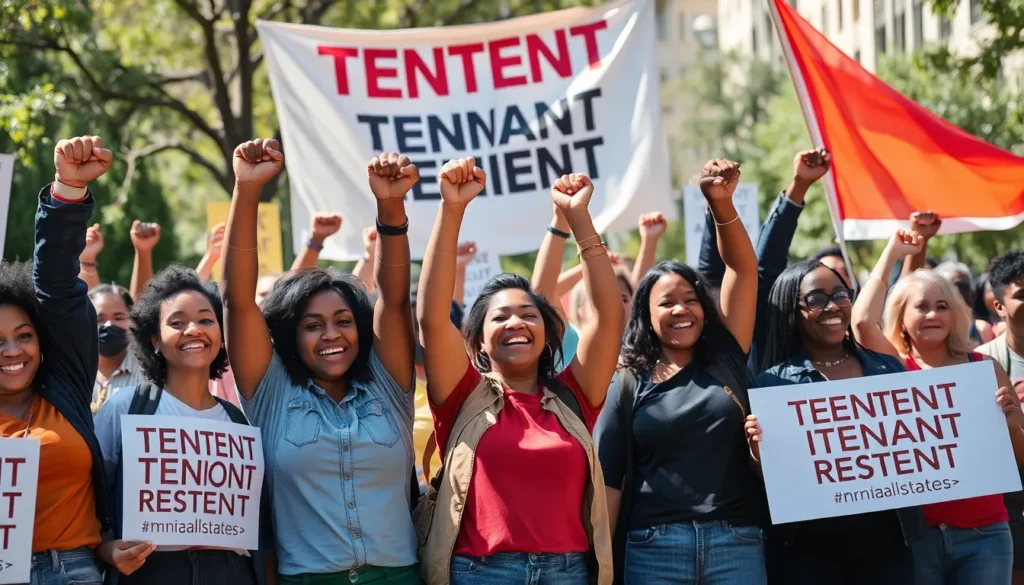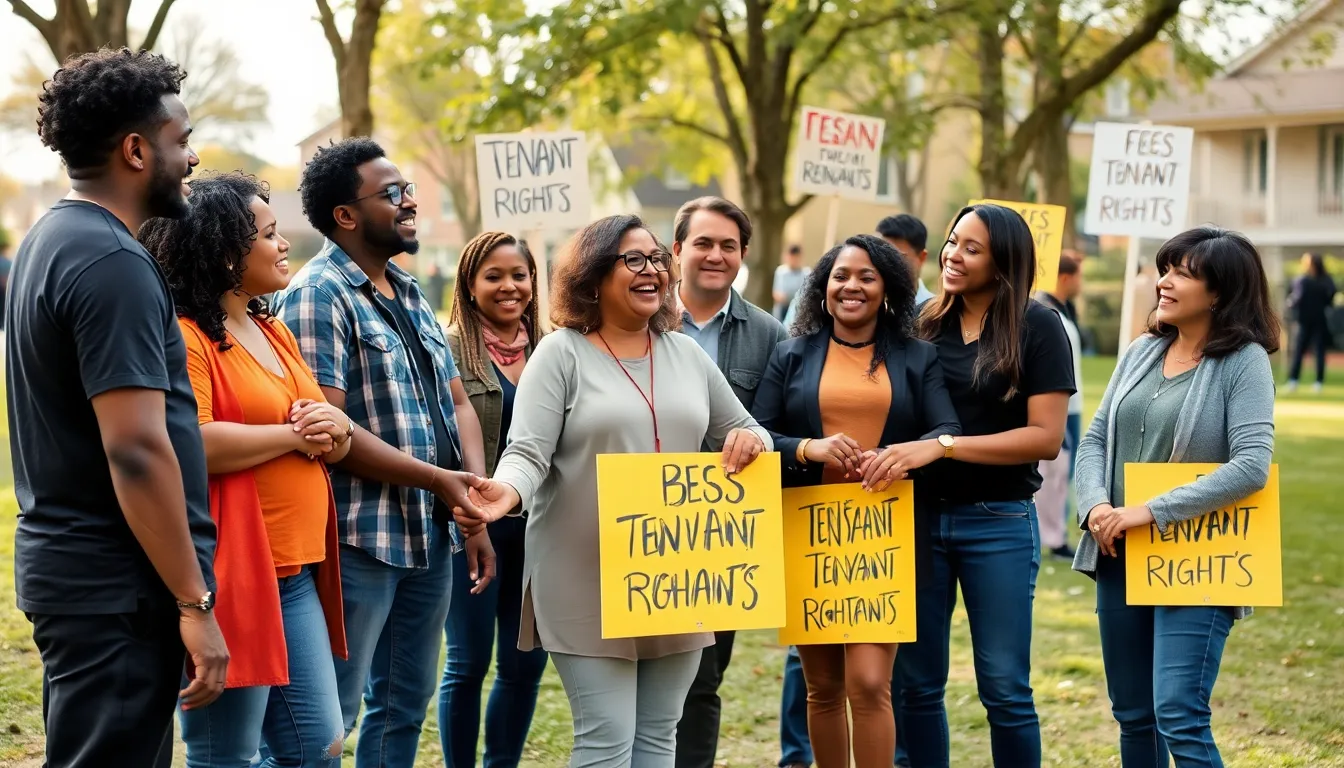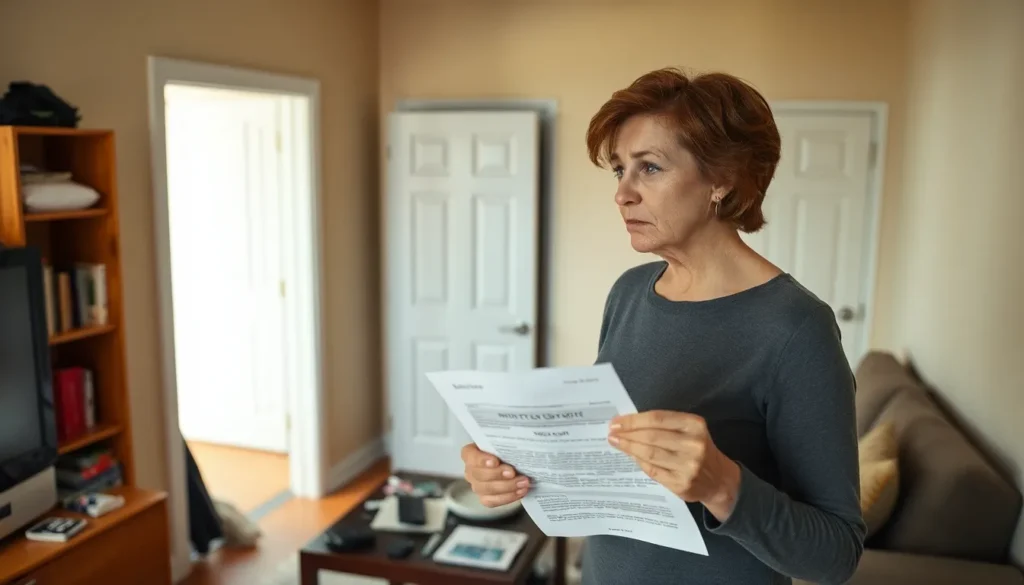Table of Contents
ToggleIn a world where landlords seem to have all the power, tenant unions are stepping up to level the playing field. These grassroots organizations are like the Avengers of the rental world, uniting tenants to fight for their rights and demand better living conditions. Who knew that a group of people with a shared love for pizza and not-so-fond memories of broken heaters could become a force to be reckoned with?
Tenant unions not only tackle issues like rent hikes and maintenance woes but also create a sense of community among renters. They’re proving that when tenants band together, they can turn the tide against unfair practices and make their voices heard. So grab your favorite snack and settle in, because the story of tenant unions is one of empowerment, camaraderie, and maybe even a few laughs along the way.
Overview of Tenant Unions
Tenant unions play a critical role in promoting renters’ rights. These organizations form to address common concerns among tenants, such as rising rents and inadequate living conditions. Through collective action, members push for fair treatment from landlords and negotiate better lease terms.
Empowerment emerges as a central theme within tenant unions. Members often experience a strengthened sense of community as they unite for a common goal. Renters can share experiences and strategies, fostering an environment of mutual support. This camaraderie motivates many tenants to advocate effectively for their rights.
Multiple benefits arise from participating in tenant unions. Advocacy initiatives can lead to improved tenant protections and equitable rent practices. Organizing events and community meetings allow renters to stay informed about housing issues. Those who join also gain access to resources, including legal guidance and educational workshops.
Tenant unions contribute to broader societal change. By standing against unjust practices, these groups help raise awareness about housing injustices locally and nationally. Many unions collaborate with local organizations and activists, amplifying their impact and driving policy reforms.
Cities across the United States witness a surge in tenant union formation. Notable examples include the Los Angeles Tenants Union and the Chicago Renters United, which inspire similar movements elsewhere. As collective power continues to grow, the ability of tenant unions to effect change remains strong.
Importance of Tenant Unions
Tenant unions play a crucial role in improving the rental market landscape. These organizations empower renters, enabling them to advocate for their rights and elevate their voices in discussions about housing conditions.
Advocacy for Tenant Rights
Tenant unions advocate vigorously for tenant rights. They address issues such as unjust rent increases, eviction threats, and poor maintenance. By organizing collective efforts, these unions strengthen the negotiating power of tenants when dealing with landlords. Legal representation becomes accessible through union resources, equipping members to collaborate on issues affecting their communities. Moreover, successful campaigns often result in more comprehensive tenant protection laws, fostering an environment where renters feel secure in their homes.
Enhancing Community Solidarity
Community solidarity flourishes within tenant unions. Members find common ground in shared experiences, promoting a sense of belonging among renters. By organizing gatherings, they create opportunities for tenants to connect and build relationships. Discussions among members often center around local housing challenges, encouraging collaborative problem-solving. Joint actions, such as rallies or community-cleanup days, enhance visibility and strengthen alliances with other local organizations. As support networks develop, tenants often report increased confidence in asserting their rights, leading to a united front against injustices.
Formation of Tenant Unions
Tenant unions form through collective efforts of renters who share common concerns about housing. Organizing requires dedication and collaboration among tenants to establish a unified front.
Steps to Establish a Tenant Union
Identifying shared issues among tenants starts the process. Gathering interested renters sets the foundation. Creating an organizing committee ensures effective planning and structure. Developing goals and a mission statement clarifies the union’s purpose. Engaging in outreach activities brings in more members. Educating members on their rights strengthens the collective’s knowledge. Finally, establishing regular meetings fosters unity and collaboration.
Challenges in Organizing
Resistance from landlords often complicates tenant union efforts. Fear of retaliation may discourage tenants from participating. Lack of awareness about tenant rights creates additional hurdles. Diverse tenant needs can hinder message cohesion. Access to resources for outreach and education remains limited in some areas. Generating sustained interest among members poses ongoing challenges. Building trust within the community takes time and consistent effort.
Role of Tenant Unions in Policy Change
Tenant unions influence policy change significantly. They engage with local governments to advocate for tenant rights and fair practices.
Local Government Interactions
Tenant unions often initiate discussions with local government officials. They present data and testimonials that highlight housing issues. These interactions lead to awareness of tenant challenges, prompting officials to consider new policies. Collaboration between unions and government entities often results in joint community meetings and forums. These platforms provide renters a voice in policy formation, creating opportunities for dialogue around pressing housing issues.
Impact on Housing Legislation
Legislation frequently reflects the collective efforts of tenant unions. Advocacy campaigns often aim to establish stronger tenant protections and fair housing practices. Success stories demonstrate how coalition efforts can lead to the introduction of new laws that safeguard renters’ rights. Creating and promoting comprehensive housing policies results from consistent lobbying by tenant organizations. Lawmakers increasingly recognize the value of listening to tenants, which contributes to a shift toward equitable housing legislation.
Successful Examples of Tenant Unions
Tenant unions are making significant impacts across various communities, showcasing effective advocacy and solidarity among renters. Notable examples demonstrate successful campaigns that provide insights into best practices.
Case Study: Los Angeles Tenants Union
Los Angeles Tenants Union (LATU) exemplifies successful tenant organization. Founded in 2015, LATU mobilizes renters to fight against unjust rent increases and eviction threats. The union engages members through outreach efforts that inform them about their rights. LATU organizes community events, uniting diverse groups to address common housing issues. Through collective action, this organization successfully influenced local policies, resulting in stronger tenant protections within the city. LATU’s approach emphasizes grassroots organizing and continuous member education, allowing tenants to effectively advocate for their rights.
Lessons Learned from Successes
Successful tenant unions provide valuable lessons that other groups can harness for their initiatives. Collaboration among members strengthens collective action, fostering a sense of community. Engaging in direct outreach builds awareness and encourages participation. Regular meetings allow for transparent communication and goal setting. These unions also demonstrate the importance of educating members about their rights, empowering them to advocate effectively. Policies shaped by tenant input often lead to more equitable housing practices. Overall, these successes highlight the power of unity in improving tenant rights and negotiations with landlords.
Future of Tenant Unions
Tenant unions continue to evolve, reflecting the changing rental landscape and tenant needs. Increased engagement and collective action shape their future.
Trends and Predictions
Growing awareness around housing issues drives tenant union membership. Many renters seek solidarity in addressing shared concerns, leading to larger and more organized unions. Technology plays a crucial role, facilitating communication and coordination among members. Digital platforms enable quicker mobilization and raise awareness about tenant rights. Predictions indicate that more unions will emerge in urban areas, driven by rising rents and housing insecurity. Local governments might also respond with more supportive policies, recognizing the influence of these organized groups.
Opportunities for Growth
Expansion in tenant union membership presents various opportunities. Collaborations with local nonprofits can enhance outreach efforts and provide additional resources. Collective bargaining power can strengthen as more renters join unions, increasing their ability to negotiate favorable terms. Educational initiatives about tenant rights can increase member awareness and engagement. Developing partnerships with other social justice organizations can broaden advocacy efforts, sparking community support. Establishing networks among different unions fosters knowledge sharing and strategic planning. These combined efforts can amplify impact and bring about transformative changes in rental housing practices.
Conclusion
Tenant unions are reshaping the rental landscape by empowering renters to unite for their rights. As these organizations continue to grow in membership and influence, they create a stronger voice for tenants facing challenges in their housing situations. The collaborative efforts within these unions not only lead to better protections and fair practices but also foster a sense of community among members.
With increasing awareness of housing issues, the future looks promising for tenant unions. Their ability to mobilize and advocate for change will likely lead to more supportive policies and improved living conditions. As renters join forces, the potential for transformative impact on housing practices becomes even greater.








